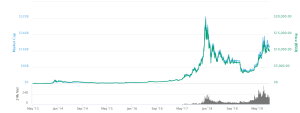Understanding Bitcoin’s Price Volatility: A Comprehensive Guide
Unravel the mysteries of Bitcoin’s price! This guide dives deep into the factors influencing Bitcoin’s volatile nature, from short-term spikes to long-term trends. Become a Bitcoin price expert today!
The price of Bitcoin, a decentralized digital currency, is notoriously volatile․ Its value fluctuates constantly, influenced by a complex interplay of factors․ Understanding these factors is crucial for anyone interested in investing in or simply learning about this revolutionary technology․ This comprehensive guide will explore the intricacies of Bitcoin’s price movements, examining both the short-term swings and the long-term trends that shape its market value․ We’ll analyze the key drivers behind these fluctuations and offer insights into navigating this dynamic landscape․
Understanding the Fundamentals of Bitcoin’s Price
Before delving into the specifics of price fluctuations, it’s essential to grasp the fundamental principles underpinning Bitcoin’s value․ Unlike traditional fiat currencies backed by governments, Bitcoin’s value is derived from its scarcity, its underlying technology, and market demand․ The limited supply of 21 million Bitcoins, coupled with increasing adoption and usage, contributes significantly to its price appreciation․ However, several other elements play a crucial role․
Scarcity and Supply
The inherent scarcity of Bitcoin is a primary driver of its value․ Unlike fiat currencies that can be printed at will, Bitcoin’s supply is predetermined by its algorithm․ This limited supply creates a deflationary pressure, potentially driving up its price over time, especially as demand increases․ The predictable nature of Bitcoin’s supply, unlike the often unpredictable monetary policies of governments, makes it an attractive asset for some investors․
Technological Advancements and Innovation
The continuous development and improvement of the underlying Bitcoin technology, including the Lightning Network for faster and cheaper transactions, influence its price․ Positive technological developments often lead to increased investor confidence and higher demand, pushing the price upwards․ Conversely, significant technical challenges or security vulnerabilities could negatively impact market sentiment and depress the price․
Market Sentiment and Speculation
Bitcoin’s price is heavily influenced by market sentiment and speculation․ News events, regulatory announcements, and even social media trends can significantly impact investor confidence and drive price volatility․ Positive news often leads to a surge in demand, while negative news can trigger sell-offs and price drops․ This inherent volatility is a defining characteristic of the Bitcoin market․
Factors Influencing Bitcoin’s Price Volatility
The volatility of Bitcoin’s price is a double-edged sword․ While it presents opportunities for significant profits, it also carries substantial risks․ Understanding the factors that contribute to this volatility is paramount for informed decision-making․
Regulatory Uncertainty
The regulatory landscape surrounding Bitcoin varies significantly across different jurisdictions․ Changes in regulatory frameworks, whether favorable or unfavorable, can significantly impact the price․ Uncertainty about future regulations often leads to price fluctuations as investors react to potential changes in the legal environment․
Adoption Rates and Mainstream Acceptance
The growing adoption of Bitcoin by businesses and individuals is a crucial factor influencing its price․ Increased acceptance by mainstream institutions, such as payment processors and financial institutions, can significantly boost demand and drive price appreciation․ Conversely, a slowdown in adoption rates can dampen investor enthusiasm and lead to price declines․
Macroeconomic Factors
Global macroeconomic factors, such as inflation, interest rates, and economic growth, also play a significant role in Bitcoin’s price․ During periods of high inflation or economic uncertainty, investors may seek refuge in Bitcoin as a hedge against inflation or a store of value․ This increased demand can push the price upwards․
Mining Difficulty and Energy Consumption
The difficulty of mining new Bitcoins and the energy consumed in the process can also indirectly influence its price․ Increased mining difficulty makes it more expensive to mine new coins, which can affect the supply dynamics and potentially support price stability․ However, concerns about the environmental impact of Bitcoin mining can also negatively influence its perception and price․
Analyzing Bitcoin Price Trends: Short-Term vs․ Long-Term
Analyzing Bitcoin’s price requires considering both short-term and long-term trends․ Short-term price movements are often driven by market sentiment and speculation, while long-term trends are influenced by fundamental factors such as adoption rates and technological advancements․ Understanding these different timeframes is crucial for developing effective trading or investment strategies․
Short-Term Price Fluctuations
Short-term price fluctuations can be highly volatile, influenced by news events, social media trends, and speculative trading․ These fluctuations can be difficult to predict and often represent a high-risk, high-reward scenario for traders․ Technical analysis tools and charting techniques are often employed to identify short-term opportunities․
Long-Term Price Trends
Long-term price trends are generally more stable and predictable, influenced by fundamental factors such as adoption rates, technological advancements, and macroeconomic conditions․ Fundamental analysis is more appropriate for assessing long-term price trends and evaluating the underlying value of Bitcoin․
Strategies for Navigating the Bitcoin Market
Navigating the Bitcoin market requires a combination of knowledge, caution, and a well-defined strategy․ It is crucial to understand your risk tolerance and to diversify your investments․ Do not invest more than you can afford to lose․
Risk Management and Diversification
Effective risk management is crucial in the volatile Bitcoin market․ Diversifying your investments across different asset classes can help mitigate risk and reduce the impact of potential losses․ Never put all your eggs in one basket․
Fundamental vs․ Technical Analysis
Both fundamental and technical analysis can provide valuable insights into the Bitcoin market․ Fundamental analysis focuses on the underlying value of Bitcoin, while technical analysis uses charts and indicators to identify potential trading opportunities․ A combination of both approaches can provide a more comprehensive understanding of market dynamics․
Staying Informed and Educated
Staying informed about the latest developments in the Bitcoin market is essential for making informed decisions․ Follow reputable news sources, research reports, and industry experts to stay up-to-date on market trends and potential risks․
The Future of Bitcoin and its Price
Predicting the future price of Bitcoin is inherently challenging due to its volatility and the many factors influencing its value․ However, several factors suggest that Bitcoin will continue to play a significant role in the global financial landscape․ The growing adoption of blockchain technology, the increasing demand for decentralized finance (DeFi), and the potential for Bitcoin to become a mainstream store of value all contribute to its long-term potential․
Several challenges remain, including regulatory uncertainty, scalability issues, and environmental concerns related to energy consumption․ These challenges will likely continue to shape the future of Bitcoin and influence its price trajectory․ However, the underlying technology and its potential for disruption are hard to ignore․
- Increased institutional adoption
- Development of layer-2 solutions
- Growing awareness and education
Despite the inherent uncertainties, Bitcoin’s potential for long-term growth remains significant․ Its unique properties, such as decentralization and scarcity, make it an attractive asset for investors seeking diversification and exposure to the emerging digital economy․ The continuous evolution of the technology and the ever-changing regulatory environment will undoubtedly shape its future price․
Ultimately, the price of Bitcoin will be determined by the interplay of numerous factors, making it a complex and dynamic market․ Continuous learning, thorough research, and prudent risk management are essential for anyone engaging with this innovative asset․
Understanding the intricate mechanisms driving Bitcoin’s price is critical for navigating its volatile landscape․ Thorough research, informed decision-making, and a cautious approach are vital for success in this ever-evolving digital frontier․ Remember that the future of Bitcoin, like any emerging technology, is uncertain, but its potential for impact is undeniably profound․
Careful consideration of risk is paramount․ Investors must exercise due diligence and understand the inherent volatility before committing any capital․ The information provided here is for educational purposes only and should not be considered financial advice․
The journey into understanding the Bitcoin market is a continuous process of learning and adaptation․ Staying informed and remaining adaptable are key to navigating this exciting, yet uncertain, world of digital currencies․







